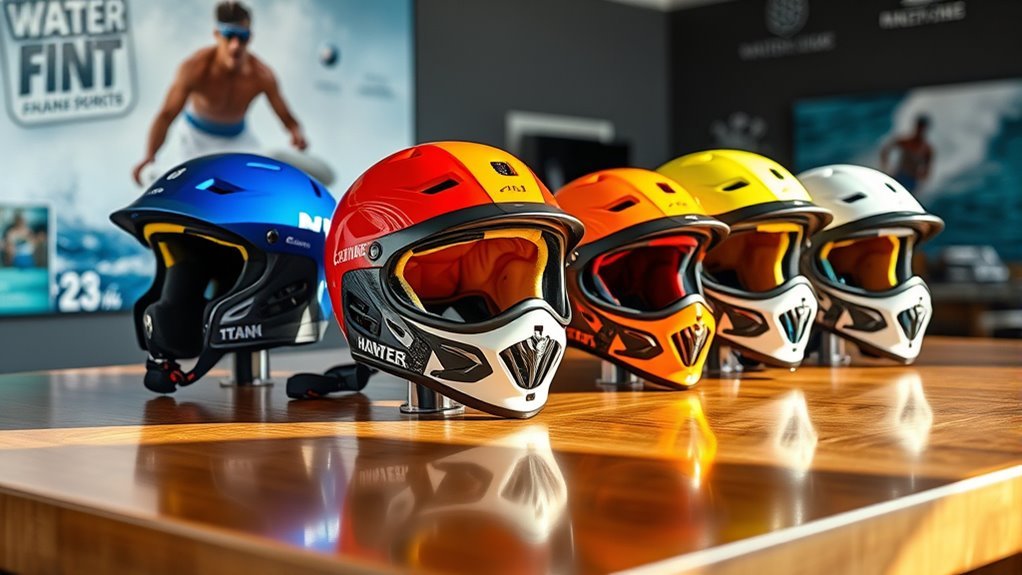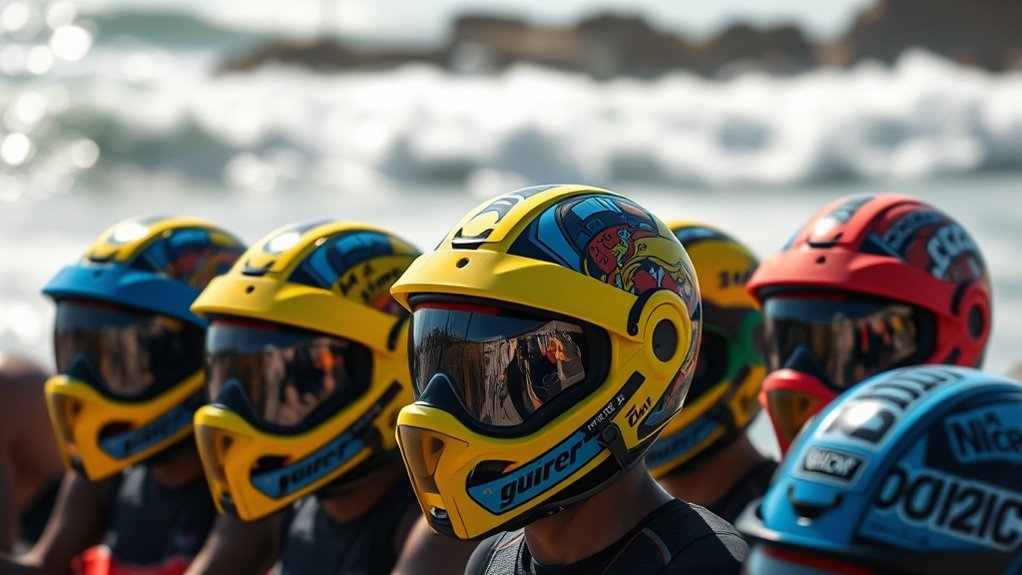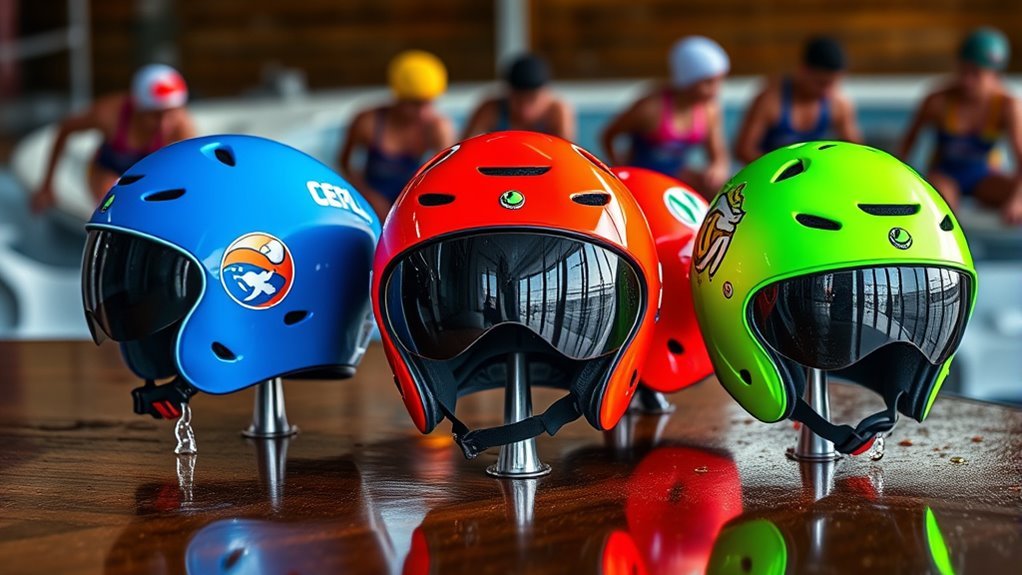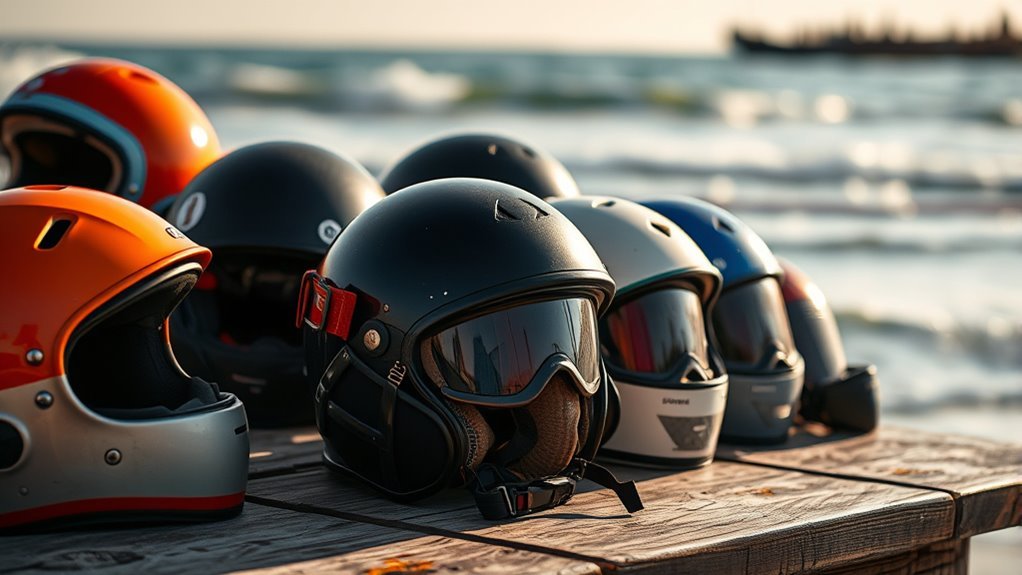History of Helmets in Competitive Water Sports
The history of helmets in competitive water sports reflects a continuous evolution aimed at enhancing safety and performance. Early designs were basic, utilizing leather or canvas, while modern helmets leverage advanced materials like carbon composites for improved protection and comfort. The influence of competitive events and athlete feedback has driven stricter regulations and innovations. Organizations play an essential role in promoting helmet use, fostering a culture of safety. You might find it interesting to explore more about the latest trends shaping this significant gear.
The Early Beginnings of Water Sports Safety

As water sports gained popularity in the early 20th century, safety became a pressing concern for participants and organizers alike. The rise of early watercraft, from rudimentary canoes to motorized boats, highlighted the need for effective safety measures. You’d notice that competitions began implementing regulations to mitigate risks, such as mandatory life jackets and designated safety zones. Organizers recognized that enthusiasm for freedom on the water couldn’t overshadow the necessity of protection. By fostering a culture of safety, they encouraged participants to embrace their adventurous spirits without compromising their well-being. This pivotal shift laid the groundwork for future innovations in water sports safety, paving the way for more advanced protective gear and protocols that continue to evolve today.
The First Helmets: Materials and Designs

While the push for water sports safety surged in the early 20th century, the development of helmets marked a significant evolution in protective gear. The first helmets, often crafted from early materials, showcased primitive designs that prioritized basic protection over comfort or style. You might find it interesting that these helmets primarily featured:
- Thick leather or canvas for durability
- Wood or metal reinforcements to withstand impacts
- Simple straps for securing the helmet in place
- Limited ventilation, affecting comfort during use
These initial designs reflected the necessity of protection while hinting at the innovation to come. As water sports gained popularity, the need for improved safety gear led to advancements that would eventually shape modern helmet designs.
The Influence of Competitive Events on Helmet Development

Competitive events have markedly shaped the evolution of helmet safety standards, pushing manufacturers to prioritize athlete protection. As you explore innovations in material design, you’ll notice how advancements stem directly from the demands of high-stakes competitions. Additionally, athlete advocacy plays an essential role, as their experiences and feedback influence helmet development to enhance both safety and performance.
Evolution of Safety Standards
Though often overlooked, the evolution of safety standards in helmet design has been greatly influenced by competitive events in water sports. These events push the boundaries of performance and, consequently, necessitate stricter safety regulations. As athletes face higher risks, the industry responds with innovations that prioritize protection without sacrificing freedom.
Key influences on helmet safety standards include:
- Increased competitive speeds leading to higher impact forces
- Stricter industry standards set by governing bodies
- Feedback from athletes on comfort and performance needs
- Technological advancements in materials and design
Each factor has shaped a landscape where safety isn’t just an option but a fundamental aspect of helmet development, ensuring athletes can pursue their passion with reduced risk.
Innovations in Material Design
As advancements in water sports demand greater performance and safety, innovations in material design have become vital to helmet development. You’ll notice that many modern helmets now utilize carbon composites, which provide a lightweight yet remarkably sturdy structure. This material not only enhances durability but also allows for greater freedom of movement, essential for athletes who need agility in competitive events. Additionally, buoyancy adjustments have become a focal point, enabling helmets to be tailored for specific water conditions. These adjustments guarantee that the helmet remains securely in place, enhancing both comfort and safety. As competition intensifies, it’s clear that these innovations in material design are not just trends but necessary evolutions that prioritize athlete performance while safeguarding against the inherent risks of water sports.
Influence of Athlete Advocacy
While the evolution of helmets in water sports has been markedly shaped by technological advancements, the role of athlete advocacy cannot be understated. Athletes have become powerful voices in promoting helmet safety and influencing regulations. Their firsthand experiences often highlight the need for improved athlete safety measures, leading to significant changes in helmet regulations.
Consider these key influences of athlete advocacy:
- Real-life experiences: Athletes share incidents that underscore the importance of helmets.
- Collaborative efforts: Partnerships with manufacturers foster innovation.
- Awareness campaigns: Advocacy groups raise public consciousness about helmet safety.
- Regulatory pressure: Athletes push governing bodies to enforce stricter helmet regulations.
This advocacy not only drives advancements in helmet design but also cultivates a culture where safety is paramount in water sports.
Technological Advancements in Helmet Manufacturing
As you explore the evolution of helmets in water sports, you can’t overlook the significant strides in materials and design that have transformed helmet manufacturing. Innovations like lightweight composites and aerodynamic shapes have not only enhanced comfort but also improved impact resistance, ensuring better protection for athletes. This shift in technology reflects a broader understanding of safety and performance that’s essential for anyone participating in water sports today.
Materials and Design Innovations
Although traditional materials like fiberglass and foam have long been staples in helmet manufacturing, recent technological advancements have propelled the industry into a new era of design and safety. You’ll find that modern helmets now prioritize both material durability and design ergonomics for a better fit and enhanced protection.
- Carbon Fiber: Lightweight yet incredibly strong, offering superior durability.
- Expanded Polypropylene (EPP): Excellent energy absorption with a flexible design.
- 3D Printing: Allows for custom designs tailored to individual preferences and needs.
- Ventilation Systems: Integrated airflow features keep you cool during intense activities.
These innovations not only improve performance but also elevate comfort, allowing you to focus on your passion for water sports without the worry of inadequate protection.
Impact Resistance Improvements
With advancements in helmet manufacturing, impact resistance has become a focal point for enhancing safety in water sports. You’ll find that modern helmets now utilize advanced materials and innovative designs that notably improve impact absorption. For instance, multi-layer foam systems can dissipate energy more effectively during collisions, reducing the risk of concussions and other injuries. Safety testing protocols have evolved, too, incorporating real-world scenarios to guarantee helmets can withstand the forces encountered in competitive environments. These rigorous assessments offer peace of mind, allowing you to push your limits without compromising safety. As you navigate the waves, knowing you’ve got reliable protection lets you embrace the freedom of your sport while minimizing risk. The future of helmet technology is brighter and safer than ever.
The Role of Organizations in Promoting Helmet Use
While many water sports enthusiasts may underestimate the importance of helmet use, organizations dedicated to safety are actively working to change that perception. Through targeted advocacy campaigns and the establishment of safety regulations, these organizations play a pivotal role in promoting helmet use among participants. They aim to foster a culture of safety that empowers individuals without sacrificing freedom.
Key initiatives include:
- Educational programs that raise awareness about head injuries.
- Partnerships with manufacturers to enhance helmet technology.
- Community events that emphasize the importance of protective gear.
- Lobbying for stricter regulations to guarantee helmet compliance in competitions.
Modern Innovations in Helmet Design
As organizations push for greater helmet use in water sports, innovative designs are emerging that prioritize safety without compromising comfort and performance. Modern helmets incorporate advanced impact technologies that effectively absorb and disperse energy during collisions, greatly reducing the risk of injury. You’ll notice ergonomic features tailored to fit the contours of the head, enhancing stability while ensuring a snug yet comfortable wear. These innovations allow for better airflow and lighter weight materials, making it easier for you to maintain agility in the water. Additionally, customizable options enable athletes to express their individuality while adhering to safety standards. With these advancements, you can enjoy your sport with confidence, knowing that your helmet is engineered for both protection and freedom.
The Future of Helmets in Water Sports
As technology continues to advance, the future of helmets in water sports looks promising, with new innovations set to revolutionize safety standards and user experience. You’ll see future trends in helmet technology that enhance both protection and comfort, allowing you to enjoy your sport with confidence.
Expect improvements like:
- Smart helmets equipped with sensors for real-time data tracking.
- Lightweight materials that provide superior protection without added bulk.
- Customizable designs to match individual styles and preferences.
- Integrated communication systems for improved safety during events.
These advancements aim not just to safeguard you but to enhance your freedom on the water, allowing you to push your limits while staying protected. Embrace the future of water sports helmets!
Frequently Asked Questions
How Do Helmets Improve Safety in Water Sports?
Helmets greatly improve safety in water sports by mitigating impact factors during accidents. You might think they’re cumbersome, but modern design innovations make them lightweight and comfortable, allowing you to focus on the thrill of the sport. These helmets absorb shock and provide essential head protection, enabling you to enjoy high-speed pursuits without sacrificing safety. Embracing these advancements means you can experience the freedom of water sports while minimizing risks effectively.
What Are the Common Injuries Helmets Protect Against?
Helmets protect against several common head injuries in water sports, like concussions and skull fractures. Their design focuses on impact protection, absorbing shock from collisions or falls. By wearing a helmet, you greatly reduce the risk of serious trauma, allowing you to enjoy the thrill of the sport with greater confidence. Embracing the freedom of your chosen activity, it’s essential to prioritize safety while still relishing every exhilarating moment on the water.
Are There Specific Helmets for Different Water Sports?
Yes, there’re specific helmets tailored for different water sports. Surf helmets, designed for impact resistance, often feature ventilation for comfort during rides. They prioritize lightweight materials to guarantee you maintain agility on the waves. On the other hand, kayak helmets offer enhanced protection from both impacts and water hazards, typically having a snug fit and ear protection. Each helmet serves a unique purpose, allowing you to enjoy your sport while minimizing the risk of injury.
How Should Helmets Be Properly Fitted for Safety?
Imagine a snug embrace around your head, ensuring safety as you ride the waves. To properly fit your helmet, use fitting techniques like the two-finger rule—ensuring it’s not too tight or loose. Adjustment methods should include tightening the straps for a secure feel without discomfort. Make sure it sits low on your forehead, covering your temples, to maximize protection while allowing freedom of movement. A well-fitted helmet can be your best ally in the water.
What Are the Maintenance Tips for Water Sport Helmets?
To maintain your water sport helmet, use gentle cleaning techniques with mild soap and water to remove grime. Avoid harsh chemicals that could damage the material. After each use, dry it thoroughly and store it in a cool, dry place away from direct sunlight to prevent warping. Regularly inspect for any signs of wear or damage, and replace it if necessary to guarantee peak safety during your adventures on the water.





